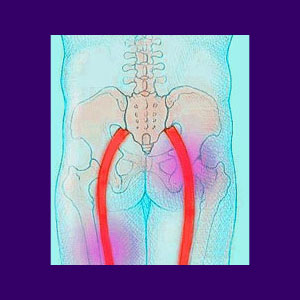
Chronic piriformis pain is a common lower body nerve pain condition which affects so many back pain sufferers. However, the very concepts often used to diagnose piriformis syndrome are often flawed. Many cases are misdiagnosed, leading to chronic pain and long-term suffering without relief.
Piriformis syndrome is a highly controversial diagnosis, since it is mostly identified by exclusion and speculation, rather than by verifiable methods. Even in patients in which the piriformis muscle is definitely involved, the role of the piriformis is often coincidental or contributory, not solely causative.
This critical essay delves into the causes of long-lasting and therapy-defiant piriformis-related symptoms.
Causes of Chronic Piriformis Pain
Piriformis syndrome definitely exists, but not usually for the reasons speculated upon by some care providers. Most patients are theorized to be suffering with muscular contractions of the piriformis muscle which impinge upon the sciatic nerve as that neurological structure passes through the anatomical vicinity. In many cases, this can be accurate, but the reason for the contractions is the subject of debate. Most doctors believe there to be some sort of physical injury to the piriformis muscle, which is rarely true. I mean truly rare.
The majority of piriformis pain syndromes are enacted by regional ischemia and often affect other soft tissues and nerves in addition to those already known to be involved in piriformis syndrome. This explains the great diversity of symptoms (many of which occur above the affected level) which are often present and difficult to account for with simple sciatic nerve impingement, as well as the reason why so many piriformis treatments fail… miserably.
In other cases, the cause of pain may be structurally-motivated by muscle imbalances or other soft tissue pathologies. However, these seem to represent the minority of diagnosed patients.
Chronic Piriformis Pain Treatments
Typical care practices for ongoing piriformis issues include physical therapy, pharmaceutical pain management, prolotherapy and direct anesthetic injections. Botox is a more recent addition to the piriformis syndrome treatment sector, as well. Botox has been shown to reduce the expression of muscular cramping deemed causative for sciatic nerve impingement in some patients. Luckily, surgery is almost never indicated or used, sparing these patients from the cruel fate suffered by so many back pain victims with diagnosed spinal causations.
In my experience, very few cases of piriformis syndrome resolve from traditional care. Some patients find no solace from care, while others develop related pain nearby. However, in some cases, knowledge therapy may work well when the source of the muscular contractions turns out to be ischemic, rather than injury-related. This is certainly a logical underlying causative process in many chronic cases.
Chronic Piriformis Symptoms
Sure, the piriformis could actually be the main source of symptoms. But, why do you think it is in constant spasm? The answer is generally clear…
Oxygen deprivation keeps the muscle illogically contracted, enacting the pain and neurological symptoms you fear so much. If you can treat the underlying cause of the ischemia syndrome effectively, then the muscle should relax and the pain should cease.
Remember that stress is known to cause muscular tension and tightness anywhere in the anatomy. Why would the piriformis be any different? This is exactly why knowledge therapy offers an approach to treatment unmatched by the usual medical and chiropractic practices. It actually targets the lesser known, but far more logical suspected source of spasms. Best of all, the treatment is free! Free of all costs and all risks.
For patients with known injury to the piriformis and patients who demonstrate an anatomical abnormality in which the sciatic nerve travels directly through the piriformis muscle, medical care may be appropriate and even necessary. These cases are not the rule, but may be justifiable exceptions given particular circumstances.




